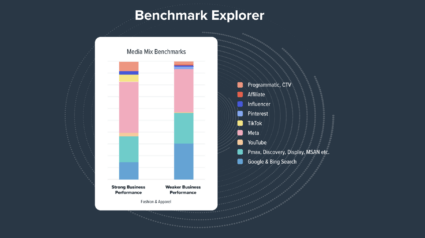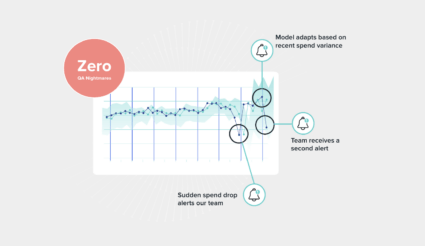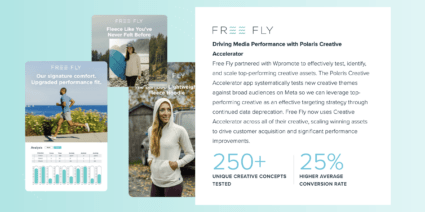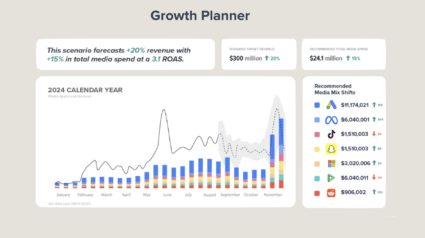In 2024, agility is crucial: brands need to adapt their strategy quickly to sudden twists like new privacy regulations, AI innovations, and even the (unlikely) possibility of a TikTok ban.
But that’s not always easy–modern marketing requires a comprehensive and privacy-compliant data strategy, flexible budget, and a diversified media mix powered by optimized creative.
With the right strategies and tools to back you up, your brand can still win. Our experts have zeroed in on four critical capabilities you need in place to keep up with the market to share how Wpromote’s Polaris tech will empower your brand to level up while preparing for the future.
1. Watch the market: continuously monitor new developments
To win in today’s climate, you need to stay on top of the newest developments in marketing, across your industry, and among your target audience. That’s easier said than done: updates sometimes feel like they’re a mile a minute, and it can be challenging to keep a finger on the pulse.
When it comes to audience trends, tools like Google Trends and social listening can help you find what consumers are talking about in real time. It’s also a good idea to monitor forums like Reddit, where online audiences often gather to share opinions on everything from politics to products. Because they move so quickly, forums might be able to give you a first indication of a public relations issue for your brand or a new trending product.
But audience shifts aren’t enough. You also need to keep an eye on your category and the trends specific to advertising in your particular market. Wpromote’s Benchmark Explorer, one of Polaris’ most powerful apps, helps our clients stay ahead of any changes by aggregating trends across our entire client portfolio. We can observe trends across clients, 22 verticals, 194 subverticals, and their entire ad tech stack, keeping cross-client trends readily accessible.

We have established alerts for over 4,000 metrics across our entire client portfolio. We use this information to analyze commonalities across these metrics, like conversion rates or spikes in impressions, to help clients evaluate potential challenges or capitalize on opportunities.
2. Get flexible: act fast to maximize marketing impact
You need to stay vigilant to make sure you’re catching and responding to any real-time changes in marketing performance, whether that’s a steep drop in conversions or an uptick in searches for a particular product.
Wpromote’s Anomaly Detection tool acts as a powerful alert system: it monitors all key KPI metrics for irregularities or sudden shifts, so we know right away if there are any significant changes in the metrics that matter most to our clients.

Knowing something has changed is only part of the battle; then you need to be ready to respond quickly. Make sure all of your teams are communicating effectively by reducing silos as much as possible so your data and/or budget isn’t stuck in different channels.
If walls are too high between different teams, you won’t be able to shift budget effectively to adjust to increased demand or a drop in another metric. That puts you at a disadvantage, since making quick pivots to capitalize on (sometimes short-lived) trends is the name of the game in today’s fast-moving online landscape.
Here’s an example: if an unaffiliated celeb posts about one of your products, you have an amazing opportunity to take advantage of buzz from that celeb’s followers. But you need to move fast to make the most of it. You might consider launching new social and programmatic campaigns for that specific product immediately (ideally within hours) to augment and extend the impact, but that can’t happen if your teams aren’t communicating and working together.
3. Adapt to data shifts: jump-start creative testing
The era of data deprecation has arrived and new laws and restrictions are regulating how marketers can collect and use personally identifiable information (PII). As audience targeting gets harder, marketers have had to face a new reality: creative is becoming the new targeting.
Instead of relying on cookie-based targeting, your marketing will need to deploy content and creative that resonates with your specific target audiences at every touchpoint on the customer journey.
But producing more optimized creative will be a challenge; as any marketer knows, making that content takes time, effort, and budget. To speed up that process and optimize spend, many brands are looking for new tech solutions.
One major opportunity is AI, whether you’re using those tools for ideation, optimization, or generating the content itself. While it’s great to experiment with new tools–and you should be setting aside budget to try innovative tech–you’ll need to be careful and provide a lot of human oversight to avoid potential problems with AI-generated copy or images.
Your best bet when using AI for creative today is streamlining the ideation process. Your team will still need to think creatively–after all, they’re the ones feeding the prompts into the AI. You can create structured prompts for tools like ChatGPT, Midjourney, or DALL-E 2 that include plenty of detail about what you’re looking for. After you get the initial outputs from the AI, your team can use those ideas as a jumping-off point for a brainstorm.
But scaling creative to feed the algorithms introduces additional challenges. Wpromote built our Creative Accelerator tool to help marketers accelerate creative testing and unlock AI-powered performance gains.

Our clients use Creative Accelerator to test new creative themes quickly and efficiently so they can focus their scaled spend on the winners. Successful tests in the app aren’t just pushed to evergreen Meta campaigns: the learnings can be fed back into the entire creative strategy across channels to inform cross-platform asset creation.
4. Evolve analysis: deploy better measurement
To be successful in the new cookieless data world, brands need to leverage all the tools at their disposal to interpret their data correctly and optimize their budget for maximum performance.
There are two essential solutions you need to deploy to keep your marketing accountable to business outcomes and help you get the jump on the competition in the future:
- Incrementality testing: Incrementality testing measures how marketing is driving growth by removing purchases that would have happened anyway, so your team can understand the true impact your campaigns have on the business. Incrementality testing also helps marketers calibrate forecasting and budgeting models to true causality. With this testing in place, you can understand relative lift across tactics, audiences, and platforms to find the “next best dollar spent.”
- Media Mix Modeling: MMM is a holistic measurement approach advertisers use to determine cross-channel lift driven across all marketing efforts. It can help you find the optimal media mix across every channel and platform and forecast the budget you need.
MMMs use your past data to predict future investment. These models should also incorporate non-media variables like economic factors, inventory changes, and more to be as accurate as possible. Adding incrementality tests as a variable can also help continually improve the model’s effectiveness at predicting the most efficient places to invest.
While MMMs are a great way to predict future growth, developing this kind of model takes years of data and a lot of time, which many marketers don’t have. That’s where a new type of MMM comes in: high-velocity MMMs, like Wpromote’s Growth Planner, which use increased data availability, computing power, and automation to speed up the MMM process and make it more efficient.
A traditional MMM is like a weather forecast: it gives you insight into how your marketing will perform in the weeks ahead. Growth Planner takes that forecast a step further: instead of just telling you the weather, it can tell you what to wear. You don’t just know what’s coming, you know what to do about it. Those added insights will help you maximize full-funnel returns through agile scenario planning and media mix optimization.

With tools and strategies like these in your back pocket, your brand can build a flexible strategy that’s ready for any surprises coming your way, from data regulations to social media platform changes. If you haven’t started investing in improving your brand’s agility yet, it’s time to prepare today–before the next big change hits your business.







Responses